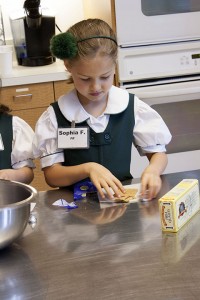Gender inequalities are examined from a Lower School cooking class.

Going into baby stores provides a visual presentation of what gender inequality really is: seeing differences where there are none between people of different genders. One garment rack is shades of pink with the occasional glittery purple shirt, while another one is full of blue and green clothing. Even activities are gendered: cars are “for boys,” while cooking is “for girls.”
However, not far from 11600 Welch Rd., a school we all know is hoping to see change.
Barbara York, the Lower School head at the St. Mark’s School of Texas, is excited for the plans of adding a cooking class into the Lower School curriculum once the science building is remodeled next year. Although St. Mark’s previously offered clubs in which the boys could cook, there has never been a required course within the curriculum.
York has been head of Lower School for 21 years. Before she was head, she ran a club called Bachelor Survival for third graders.
“We would learn to sew on buttons and to do a little basic cooking and those kinds of things, and the boys just even then thought that was really cool,” York said.
Though she ran the club 35 years ago, York remembers that even then, the boys were excited about the activities in the club.
“I think that the kids would be even more available for that now,” she said.
Thus, the remodel of the science building at St. Mark’s has perfect timing: not only will it update spaces to teach chemistry and biology, it will also include a kitchen in which the boys can cook as part of their school days.
Using the Hockaday Lower School Rotunda Learning Kitchen, kindergarten teacher Tymesia Smaw sees children’s appreciation for cooking firsthand. Smaw cooks with her students once every six-day rotation and credits the class with helping the students work on their math, reading comprehension and sharing skills.

“They love where there’s a recipe where each person gets to pour a little bit of something in,” Smaw said.
Apart from the skills the students can work on while cooking, York considered why boys, as well as girls, would enjoy cooking classes. “They certainly love food,” she said.
Hockaday Child Development Center teacher Jason Baldwin cites not only a love of food, but a love for “hands-on, messy activities” as something that appeals to both boys and girls just learning to cook.
Apart from cooking with the preschool children in the CDC, he also runs a club open to Hockadaisies from pre-kindergarten to first grade called Cooking With Books. A recent recipe was spaghetti and meatballs after reading “Cloudy With a Chance of Meatballs.”
“They’re capable of making food themselves that actually tastes really good,” Baldwin said.
The idea of capability is what he really wants them to take away from the experience. As an educator who has worked with coed audiences, Baldwin knows that there is no gender separation for children when it comes to food.
“Kids at this age, boy or girl, really enjoy [cooking],” Baldwin said, explaining that cooking classes let children realize they are “very independent and can do things themselves, and they love it.”
Introducing children of all genders to hobbies such as cooking erases barriers and differences between “gendered” activities, which will make the next generation more equal.
“I think that for boys to be able to cook, that’s an important skill,” York said. “It would give them some coping skills that they don’t have.”
Smaw, who teaches a coed cooking class at Hockaday during summer vacation, agrees.
“I can’t tell you the confidence that the students gain when they have put in all the work and all of a sudden, at the very end, they see how wonderful it is,” Smaw said. “And they made it themselves.”
Making it themselves is something that educators like Smaw, Baldwin and York want to encourage. As time goes on, activist communities who want to see their change enacted in the world are taking steps forward to shrink the gender gap.
Even for children, inequalities seem to be everywhere. For example, boys are made fun of for liking anything pink, and toys like superheroes are rarely marketed toward girls. At school, it can sometimes seem like there’s a disparity in accord with gender, even if that feeling comes from one’s peers. By comparing single-sex schools like Hockaday and St. Mark’s, those disparities can be especially apparent. The addition of a cooking class into the Lower School class offerings would neutralize the “gendered” aspect of this activity.
Additionally, according to KidsHealth.org, a website dedicated to providing parents and their children with resources on all aspects of a child’s healthy upbringing, cooking provides many benefits for boys and girls. Apart from working on school skills like math and reading, cooking can also help young kids find more food they enjoy—a tough task for many picky eaters.
While there are many benefits that come with cooking from a young age, the stilted, societally manufactured split between genders starts at a young enough age that from childhood, boys think cooking is too much of a “girly” activity for them to enjoy. Adding cooking classes into a curriculum at an all-boys school will make cooking a fun activity that students can enjoy with friends and make it an exciting part of the boys’ day.
“There are less gender restrictions now than there have ever been,” York said. “[That] gives each person a chance to use his or her natural talents or natural inclinations to find things that they truly like to do.”
– Maria Katsulos








